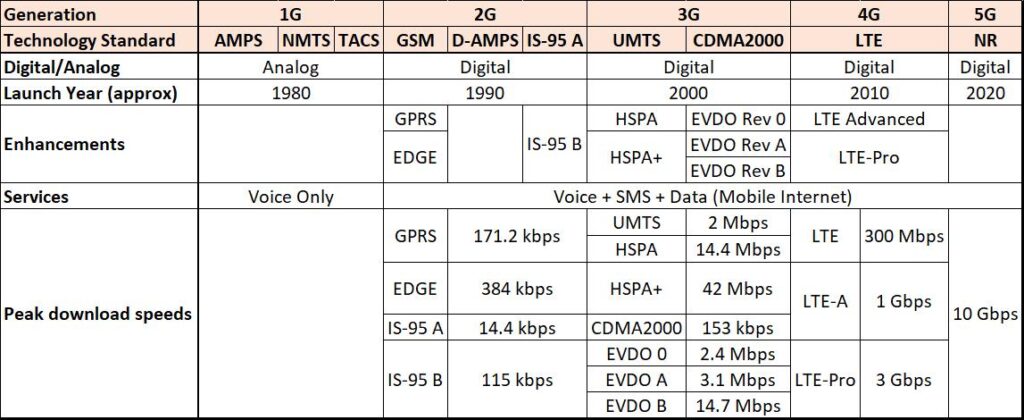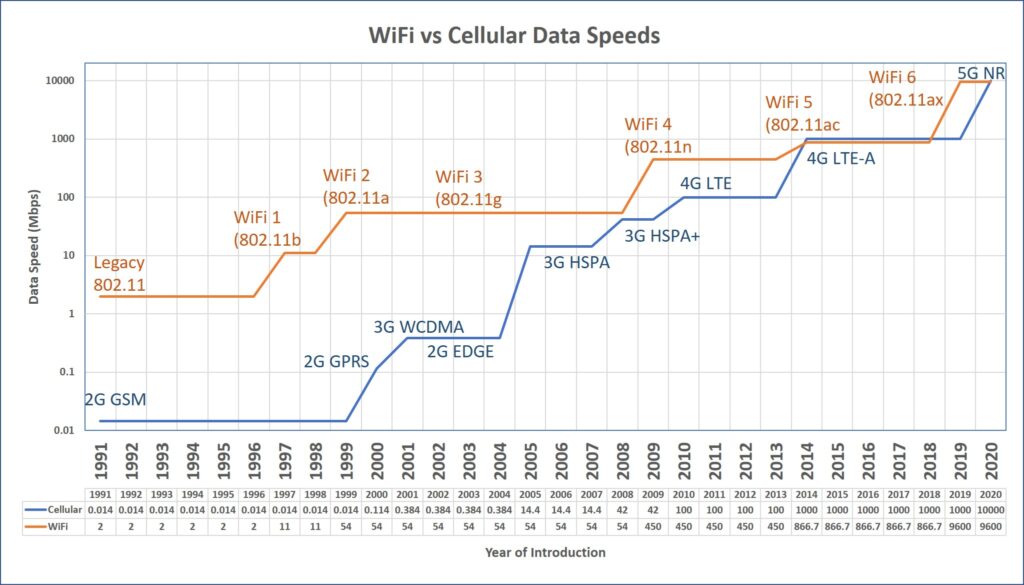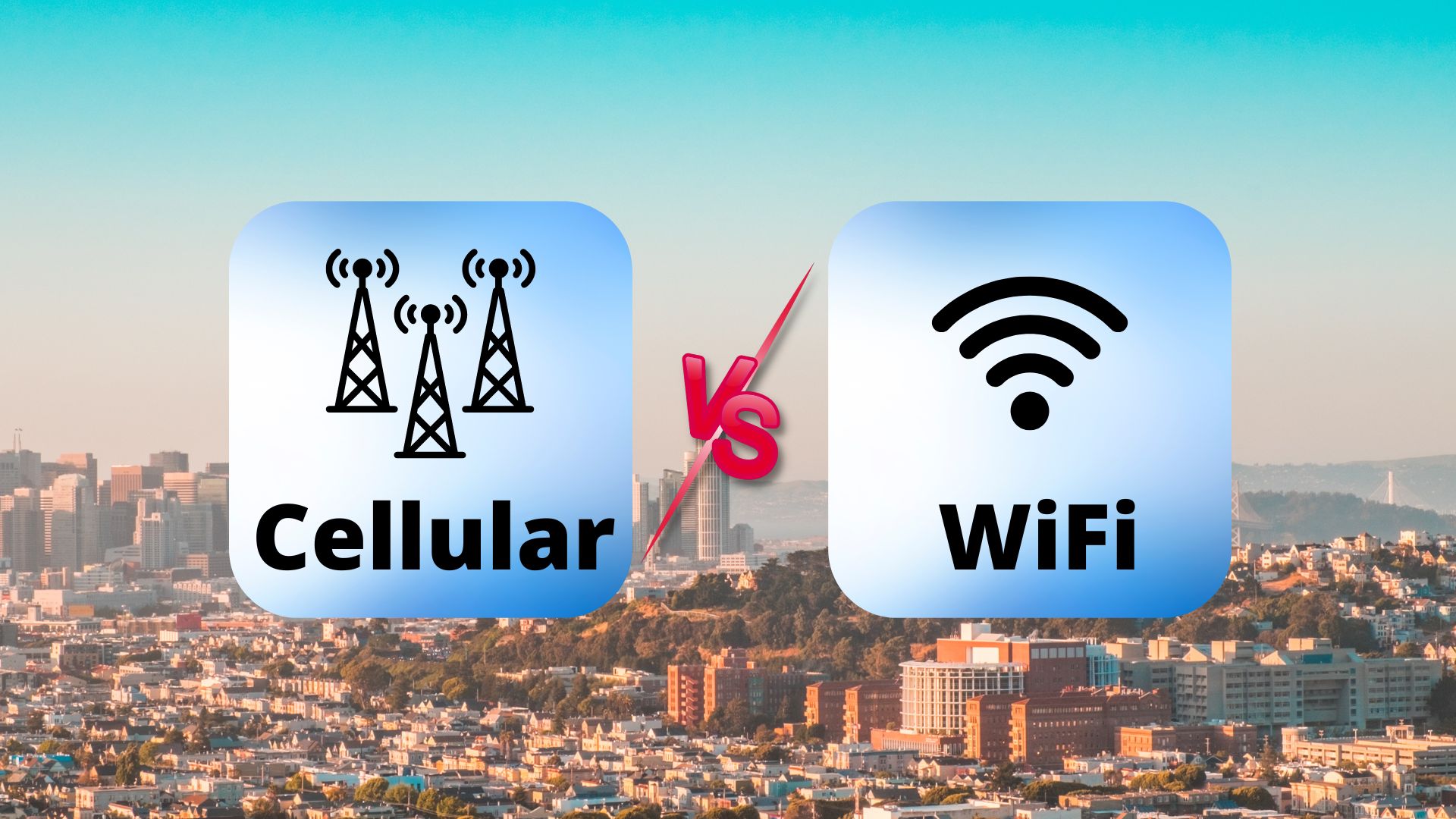What WiFi vs Cellular deployment challenges do you overcome for a robust network?
There’s long been an industry assumption that Wifi is better than Cellular networks in almost every way. As a result, ever since the arrival of the earliest smartphones, smartphones have routinely jumped on the nearest known Wifi connection and used it in preference to 2G, 3G, or 4G mobile networks for data. But now after the onset of 4G & 5G, do the mobile speeds still continue to be inferior to Wifi? Also, we will delve deeper into what are the challenges in deploying the WiFi vs Cellular Networks, in this article.
WiFi vs Cellular Data Speeds:
Why Smartphones jumped to usable WiFi:
The reason early modern smartphones made the choice to stop using cellular for data if a usable Wifi hotspot was nearby is simple to understand given the situation back then, as mentioned below:
- Wifi was faster than mobile almost all of the time. The initial smartphones only used slow 2G networks — so of course, Wifi backed by ADSL or cable modems running at many Mbps was faster. Even for later iPhones or Android smartphones, the mobile networks back in 2008/09 were only 3G, and this was also comparatively slower to the then Wifi network speeds.
- Wifi was cheaper, always. Wifi in the home or office had no marginal cost for the users, but often mobile networks charged more for plans with more data volume or in some cases for the privilege of even having any mobile data.
- Wifi had much greater capacity. With the exception of those on few initial plans with unlimited data, smartphone users had to confront limited data volumes on mobile, but unlimited data when they connected to Wifi.
The Changing Scenario
The world has changed dramatically since the dawn of the modern smartphone:
- 4G networks have launched. This new network generation has dramatically boosted the quality of smartphone users’ experience. The speeds of data downloads have increased significantly with the introduction of 4G.
- Most of the people now own a smartphone. In mature smartphone markets, this is leading to the concern of lower smartphone shipments affecting the revenues of smartphone makers.
- Mobile video consumption has exploded. Smartphones have become a mainstream way to watch TV, to such an extent that many of the video streaming companies such as Netflix have even launched mobile-only tariff plans.
- Free or cheap rates of Mobile data on 4G. A significant thrust in mobile data usage has come in India with the launch of Reliance Jio, which offered unlimited free data plans for the subscribers for a long period of time. Circumventing the situation, the other mobile operators also slashed the rates to sustain in the market. Unlimited data plans at cheap rates have significantly boosted data usage amongst the customers.
Yes, there are still places with legacy 2G/3G coverage, however, some operators have already removed 3G and some are in the process to upgrade their 3G with 4G networks in a short time. Effectively 2G-only networks will be left at those locations where 4G will not be viable in terms of cost vs revenues.
A Sneak-peak into the data speeds:
Let’s analyze the two technologies in close proximity to the speeds offered:

Fig. 1. Cellular Technology Details

Fig. 2. Wifi Technology Details
From the details above, it is clear that the data download speeds in 4G & 5G networks are touching Gbps (Billions of bits per second) rates, similar to the latest WiFi 5 & WiFi 6.
The below graph captures the data speeds in different Mobile and WiFi technologies, w.r.t. time of introduction of those technologies.

Fig. 3. WiFi vs Cellular Comparative Download Speeds
We can observe from the above graph, that although WiFi data download speeds were significantly high earlier, the same are converging with the advancement of the technologies.
Yet, looking at the changing scenario, the perception that mobile networks are inferior to Wifi has still persisted.
In the changing scenario, there is a need to review the logic of whether the smartphones should still continue to have a one-way logic of switching over to the nearest WiFi if a usable WiFi is available.
Challenges in Deployment of Cellular vs WiFi Networks:
Setting up of both – the Cellular Networks, as well as WiFi, is much more complex than often it is portrayed as. A number of challenges pose while planning and deployment of these networks.
Let’s look at some of the common challenges, followed by some unique challenges, in the deployment of Cellular & WiFi networks:
Common Challenges:
Planning Stage:
- Proper understanding of requirements & constraints:
A good network deployment starts with proper planning. Planning involves understanding the requirements and constraints and working out the most appropriate solution.
Formulating requirements are often overlooked or disregarded, because on the surface, requirements seem to be quite easy: Mobile or Wifi availability is a commodity, and it should be readily available flawlessly! Unfortunately, most customers and end-users don’t even have more than a passing knowledge of networking or information technology. Hence, they don’t appreciate what is possible vs impossible, or what is easy and cheap vs what is difficult and expensive.
- Proper product selection:
Picking the right solution and right product is very important to be able to compete in the highly competitive market. Technology is constantly evolving at a high pace. Choosing an established product today may be a wrong decision if it soon gets replaced with a new technology product with significantly higher features.
The Cellular telephony equipment are quite costly, and hence changing the products altogether will not be an easy affair. A feature in a new product may become a game-changer for one operator, but developing the same feature in existing equipment may incur a lot of time as well as costs, and at times it may not be feasible too.
In WiFi scenario, although the WiFi vendors and WiFi solutions are treated as interchangeable, however, the reality is that most network vendors have optimized their products and services to meet the typical requirements of specific vertical markets. Hence a solution tuned for one environment may be a very poor choice for another because the requirements are very different.
- Network Coverage:
A well-designed network starts with an understanding of the physical layout and where exactly the coverage is required. This is often more efficiently done by using mapping tools such as Mapinfo or NetSpot, apart from physical site surveys. Several challenges such as the terrain, the buildings, and walls, impact the transmission of airwaves, thereby affecting the network coverage. It’s always much more efficient and cost-effective to properly map out your coverage from the beginning, rather than to go back and make changes once the network has already been installed.
- Sufficient Capacity:
Once the desired coverage is determined, it’s important to plan the capacity of the network based on the expected behavior of the end-users who will be accessing it, such as the number of devices, type of devices, and how they will be using (e.g. frequency of usage, applications, etc.)
- Integration with the existing network:
Another important aspect to be considered is how will the new node [Access Point (AP) or cellular node] be connected, and will it impact the coverage of other existing AP or node. A poorly planned AP/Node may create interference, which may adversely impact the customer’s experience. Moreover, they need to be planned with respect to their associated nodes in the hierarchy (which may involve evaluating the capacity, connectivity, and software versions of all associated nodes).
- Future growth in customers/traffic:
A new node/AP is planned to be scalable so that it is able to cater to the requirements of existing and new customers in the changing scenario. The absence to consideration of this aspect may lead to challenges such as the degraded or interrupted experience of the customers.
- Roaming
Mobile device users typically want to have mobility. So the network needs to allow users and their devices to move seamlessly from AP to AP or from a Cellular node’s coverage to another node’s coverage. The expectation nowadays is that a user can move from anyone point to another point in an office, college campus, restaurant, store, hospital, or any other place, without any disruptions to the applications they are running.
- Network Security:
Each day, while the technology is evolving, the threats from hackers, viruses, malware, and other cyber-criminal elements are also rising. The network needs to be prevented from such unwanted disruptions, hence strong network security is essential for a smooth customer experience. Network security is always an ongoing challenge in such a dynamic scenario, and periodic actions need to be taken to ensure proper security of the network.
Deployment/Project Rollout:
The planning is followed by the deployment or project rollout stage. This is another challenging stage where a high level of coordination is required between different parties that are involved in different tasks. The timely deployment involves series of synchronized actions by various stakeholders.
- Procurement, Logistics, Warehousing, and Inventory Management:
Timely procurement of material for deployment is the first challenge to the success of this stage. It involves vendor finalization, negotiating and optimizing lead times for procurement, logistics, warehousing, and transit to the deployment site. Necessary safety & security measures to ensure damage-free material delivery are also important.
- Site Preparations:
On-site readiness in terms of legal contracts, space, power, connectivity, etc. is required to be done before the actual equipment reaches so that the idle time of the equipment is minimal.
- Deployment Team:
The deployment teams should be aligned as per the readiness of the site and the equipment. At times the challenges may be posed due to insufficient skills of the deployment team, or human resource issues as well.
- Alignment with teams handling associated nodes:
The cellular nodes or AP’s may need to be connected with other nodes, for which synchronized actions are required by other teams as well. Necessary alignment with such teams is important to ensure timely and smooth implementation of the new network nodes.
- Troubleshooting of issues:
Sometimes, the new nodes do not function properly after they have been installed and configured. This requires them to be troubleshot to find and resolve the issues. The known issues may be immediately resolved, but some issues may lead to significant time in resolution, which can delay the deployment.
- Acceptance Testing and Go-live:
At this time, the deployed equipment is tested for its proper installation & functionality. Challenges in the form of inferior-quality installation, abnormal or inconsistent observations of tested results in its functionality, etc. can be observed at this stage, which is resolved by the deployment team.
Once the Acceptance Testing is completed, the node is declared as go-live and goes into normal operations mode.
Operations:
Once the network is made on-air, any operational issues are dealt with to ensure optimum performance.
- Network Availability:
After the network is made on-air, if the services get disrupted due to any reason (power failure, hardware or software issue, connectivity failure, etc), the customers may get impacted. Think about a person in emergency wanting to make a call, or a businessman wanting to transfer funds urgently for a critical time-bound financial deal. Networks are generally designed to have high availability, with necessary redundancy in the hardware and connectivity. Moreover, the operations teams carry out preventive maintenance activities at regular frequencies, to ensure smooth functioning of the deployed network.
- Network Optimization:
Due to the dynamic nature of the customer’s behavior, as well as with the changing demographics or natural reasons, the network coverage or capacity may not be sufficient to cater to the new scenario. In such cases, network optimization may be required, which may involve activities such as change of antenna orientation, capacity increment/decrement, feature changes, etc. Performance monitoring is necessary to keep track of the network behavior and statistics and take necessary optimization actions if required.
- Cost:
Optimizing the costs in deployment and operations of the network is another important challenge. After all, the cost versus revenues is important with any business. Hence, the network owners constantly look for ways to optimize the cost of network deployment and operations.
Unique Challenges:
- Installation Challenges:
The typical range of WiFi is less, and is generally designed to cover a premise such as a railway station, airport, mall, hotel, etc. While the customers may demand a good network in every nook and corner of the premises, they don’t want the access points or cabling visible to avoid damage to the aesthetics.
The mobile customers also demand proper coverage, however, at some of the places, they don’t want to have mobile towers or antennae due to the concern of radiation and health issues.
- Spectrum / Frequency Bands:
While the mobile operators are generally bound by their agreements to use the licensed spectrum for cellular mobile operations, WiFi operators can utilize the unlicensed frequency bands of 2.4 GHz and 5 GHz.
For offering cellular services, the mobile operators need to purchase the spectrum from the regulator at a price, which is generally high. In India, the mobile operators have been allocated the frequencies in the bands of 900 MHz, 1800 MHz, 2100 MHz, 850 MHz, 2300 MHz, 2500 MHz, which they have mostly procured through Spectrum Auctions. On the other hand, the WiFi spectrum is inexpensive as it is from unlicensed bands.
- Roaming & Handoffs:
As WiFi clients move in the network, the signal strength from different WiFi APs constantly changes. Because clients are making the decision on the best AP to connect to at any given time, consistent connectivity and reliable performance become a major issue due to inconsistent implementations by different device vendors.
With cellular wireless, roaming and handoffs between access points are coordinated and controlled by the network infrastructure. As devices move throughout the network, they report channel quality to their serving APs. The network infrastructure decides exactly when to perform handover from one AP to another AP to ensure no loss of connectivity or any data providing a consistent and uninterrupted user experience.
- Cost and Range of Products:
While the number of mobile vendors is comparatively less as compared to those of WiFi vendors, the mobile products are also comparatively costlier as compared to WiFi equipment. Hence owning and using WiFi is generally cheaper than mobile data.
Conclusion:
While many of the challenges are similar in WiFi and Cellular deployments, there are some unique challenges and requirements as well in each type of network deployments. It is more about how you plan your approach and address those challenges. Both these technologies will closely intertwine to provide a better experience to the customers

